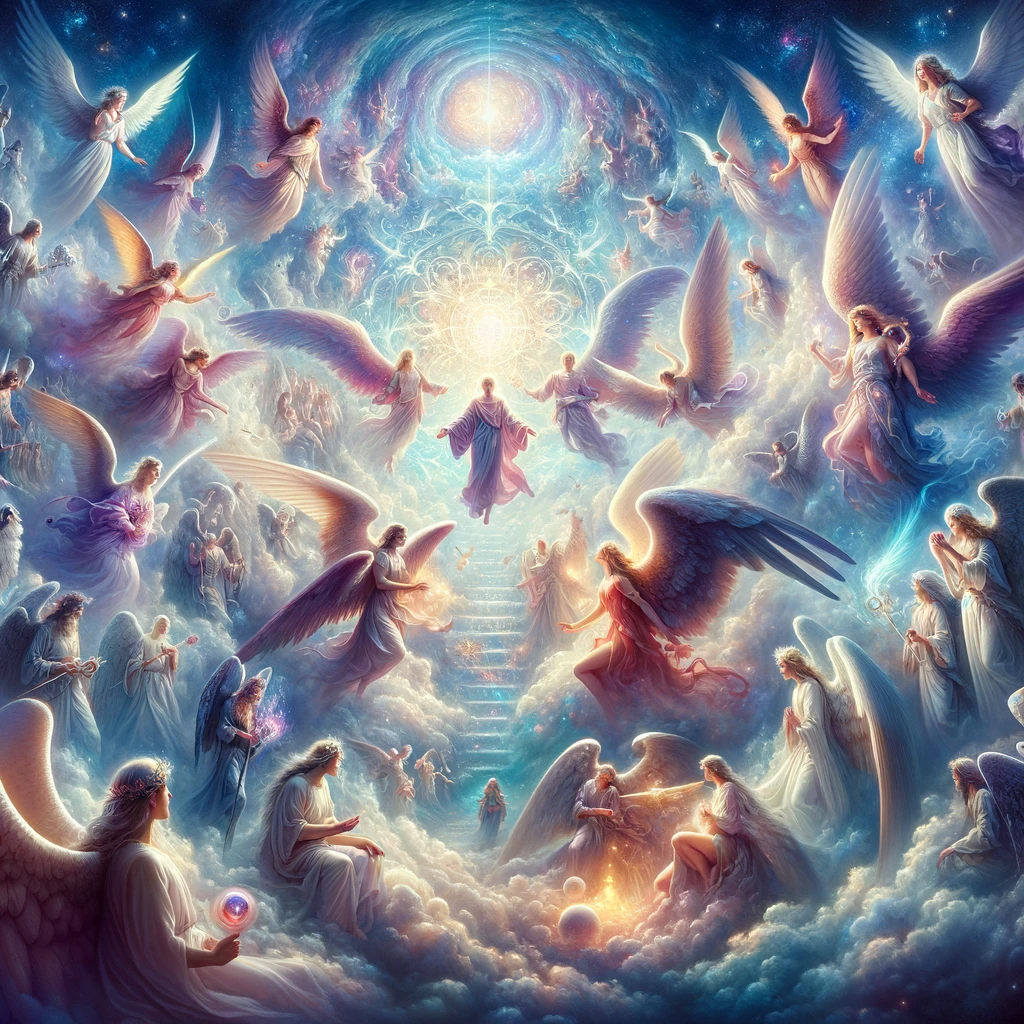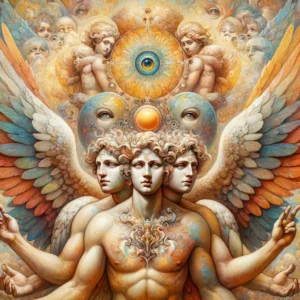
Angelology
Step into the enchanting world of Eastern Orthodox theology, where angelology takes center stage.... View more
Cherubim
-
Cherubim
Cherubim: Divine Protectors of Glory Known for their intimate knowledge of God, guardianship of His glory, and representation through multiple faces or wings.
“CHERUB or CHERUBIM (Chĕrʹ ŭ·bĭm) Class of winged angels. The Hebrew cherub (plural, cherubim) is of uncertain derivation. In the OT it is the name of a class of winged angels who functioned primarily as guards (Gen. 3:24) or attendants (Ezek. 10:3–22). The only NT reference to cherubim is in a description of the furnishings of the holy of holies (Heb. 9:5). Texts descriptive of the appearance and activities of cherubim reflect two contexts. One is in the visions of the presence of God attended by living creatures (cherubim and seraphim, Isa. 6:2–6; Ezek. 1:4–28; 10:3–22). The other is temple worship and the representations of cherubim which were a part of its furnishings (Exod. 25:18–22; 1 Kings 6:23–35; 2 Chron. 3:7–14). The most impressive of the temple cherubim were the large sculptures (probably winged quadrupeds) in the holy of holies. If these were arranged as was common in the ancient Near East, the two cherubim would together form a throne. Their legs would be the legs of the throne, their backs the arm rests, and their wings the back of the throne. Consistent with the idea of a cherub throne are the texts which envision God dwelling between, enthroned upon, or riding upon the cherubim (1 Sam. 4:4; 2 Sam. 6:2; 22:11; 2 Kings 19:15; 1 Chron. 13:6; 28:18; Pss. 18:10; 80:1; 99:1; Isa. 37:16). Even Ezekiel’s vision depicts the glory of God resting upon or between the cherubim as something of a living throne.” (1)
“The many variations of cherubim represented in the Bible—examples with one or more faces; with human, leonine, bovine, or aquiline faces; with two or four legs—correspond to various forms of composite beasts depicted in ANE art, particularly the art of Assyria (TWAT 4: 330–34). In ancient Israel and its contemporary world, cherubim were characterized by mobility, since they all had wings. By virtue of their combining features of different creatures or having more of such features than real animals or persons, they were unnatural. These characteristics made them apt symbols for divine presence, since deities moved where humans could not and were something other than either animals or humans. The cherubim of the Bible are hardly the round-faced infant cherubim known in Western art” (2)
“Archaeological discoveries have brought to light some ancient representations of creatures which may be cherubim. At Samaria ivory panels depicted a composite figure with a human face, an animal body with 4 legs, and 2 elaborate and conspicuous wings. Excavations at the ancient Phoenician city of Gebal (the Gk. Byblos) have revealed a carved representation of two similar cherubim supporting the throne of Hiram king of Gebal, who reigned c. 1000 bc.” (3)
“The cherub is equivalent to the griffin, a name found almost in the same form in Persian and in Greek. In ancient Near-Eastern mythology griffin were intermediaries between men and gods, carrying men’s prayers up to the higher beings. Cherubim are not described in detail in the Bible and it is known only that they had faces and wings. Some scholars believe that they are analogous with the beings depicted in Egyptian paintings as having the bodies of young winged boys and girls, or that they were similar to the Mesopotamian winged bulls, guardians of the temples. But it is now thought that they were represented as sphinxes, i.e. lions with human faces and outspread wings touching at the back. There are numerous representations of sphinxes in the art of Palestine during the Bronze and Iron Ages.” (4)
“In early Christian iconography it is difficult to identify c. Claims have been made for the → Rabbula Gospels. Fol. 13r (Sörries.1993, pl. 57) shows a winged creature with four heads and wheels beneath the image of Christ being carried up into heaven by angels; this is probably the image of a c. functioning as the carrier of a theophany. The 6th-c. flabellum said to have been found at Riha (→ Treasure) shows a standing human figure with the human head facing front, a lion’s head facing left, heads of an ox and eagle facing right, two human hands left and right of the image, and two human feet exposed below; the rest of this figure’s torso is covered with four wings. There are two wheels below left and right. Vikan connects this image with Ezek. 1:4ff., no doubt correctly. As for c. images in the → Bāwīt frescoes, the first hurdle is chronology—specifically, whether there are paintings here that can be dated to the early Christian period. A new critical study of c., seraphim, and living creatures would be a welcome addition to the literature of early Christian iconography.” (5)
“So the Christian Church from the first accepted the personality of the cherubim and early adopted Philo’s interpretation of the name. Clem. Alex.: “The name Cherubim intends to show much understanding (aisthesin pollen).” (Stromata, V, 240.) Though counted amongst the angels during the first centuries of Christianity, the cherubim and seraphim were not mentioned in the lists of the angelic hierarchy. At first but seven choirs of angels were reckoned, i.e. those enumerated (Ephesians 1:21 and Colossians 1:16), with the addition of angeli et archangeli. Thus St. Irenæus, Haer. II, xxx, and Origen, Peri archon, I, v. But soon it was realized that the Apostle’s list was not intended to be a complete one, and the Old Testament angelic beings mentioned by Ezechiel and Isaias, the cherubim and seraphim, and others were added, so that we have eight, nine, or ten, or even eleven ranks in the hierarchy. The cherubim and seraphim were sometimes thought to be but other names for thrones and virtues (Gregory of Nyssa, Against Eunomius I; Augustine in Ps., xcviii, 3). Since Pseudo-Dionysius, De Caelesti Hier. (written about A.D. 500), the ninefold division of the angelic order has been practically universal; and the cherubim and seraphim take the highest place in the hierarchy, a rank which was ascribed to them already by St. Cyril of Jerusalem (370) and by St. Chrysostom (about 400), and which Pope Gregory the Great, once aprocrisarius or nuncio at Constantinople, made familiar to the West. Pope Gregory divided the nine angelic orders into three choirs, the highest choir being: thrones, cherubim, and seraphim. Of the cherubim he says (Hom. in Ev., xxxiv, 10), that cherubim means “the fulness of knowledge, and these most sublime hosts are thus called, because they are filled with a knowledge which is the more perfect as they are allowed to behold the glory of God more closely”. This explanation of St. Gregory is ultimately derived from Philo’s similar statement, and was already combined with the Old Testament function of the cherubim by St. Augustine in his sublime comment on Ps., 79:2, “Who sitteth upon the Cherubim”: Cherubim means the Seat of the Glory of God and is interpreted: Fullness of Knowledge. Though we realize that cherubim are exalted heavenly powers and virtues; yet if thou wilt, thou too shalt be one of the cherubim. For if cherubim means, Seat of God, remember what the Scripture says: The soul of the just is the Seat of Wisdom.” (6)
Sources:
(1) Martin, Michael. “Cherub.” Ed. Chad Brand et al. Holman Illustrated Bible Dictionary 2003: 281. Print.
(2) Meyers, Carol. “Cherubim.” Ed. David Noel Freedman. The Anchor Yale Bible Dictionary 1992: 900. Print.
(3) Harrison, R. K. “Cherubim.” Ed. D. R. W. Wood et al. New Bible dictionary 1996: 183. Print.
(4) Negev, Avraham. The Archaeological encyclopedia of the Holy Land 1990: n. pag. Print.
(5) Finney, Paul Corby. “Cherub.” Ed. Paul Corby Finney. The Eerdmans Encyclopedia of Early Christian Art and Archaeology 2017: 300–301. Print.
(6) Arendzen, John. “Cherubim.” Ed. Charles G. Herbermann et al. The Catholic Encyclopedia: An International Work of Reference on the Constitution, Doctrine, Discipline, and History of the Catholic Church 1907–1913: n. pag. Print.-
This discussion was modified 3 months, 3 weeks ago by
Justinian of Arizona.
-
This discussion was modified 3 months, 3 weeks ago by
Justinian of Arizona.
-
This discussion was modified 3 months, 3 weeks ago by
Justinian of Arizona.
-
This discussion was modified 3 months, 3 weeks ago by
Justinian of Arizona.
-
This discussion was modified 3 months, 3 weeks ago by
Log in to reply.


